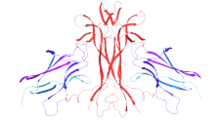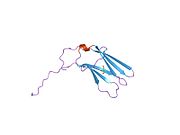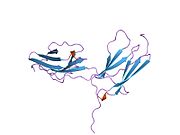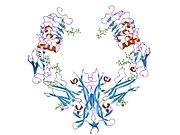Tropomyosin receptor kinase A
Ensembl | |||||||||
|---|---|---|---|---|---|---|---|---|---|
| UniProt | |||||||||
| RefSeq (mRNA) | |||||||||
| RefSeq (protein) | |||||||||
| Location (UCSC) | Chr 1: 156.82 – 156.88 Mb | Chr 3: 87.69 – 87.7 Mb | |||||||
| PubMed search | [3] | [4] | |||||||
| View/Edit Human | View/Edit Mouse |
Tropomyosin receptor kinase A (TrkA),[5] also known as high affinity nerve growth factor receptor, neurotrophic tyrosine kinase receptor type 1, or TRK1-transforming tyrosine kinase protein is a protein that in humans is encoded by the NTRK1 gene.[6]
This gene encodes a member of the neurotrophic tyrosine kinase receptor (NTKR) family. This kinase is a membrane-bound receptor that, upon neurotrophin binding, phosphorylates itself (autophosphorylation) and members of the MAPK pathway. The presence of this kinase leads to cell differentiation and may play a role in specifying sensory neuron subtypes. Mutations in this gene have been associated with congenital insensitivity to pain with anhidrosis, self-mutilating behaviors, intellectual disability and/or cognitive impairment and certain cancers. Alternate transcriptional splice variants of this gene have been found, but only three have been characterized to date.[7]
Function and Interaction with NGF
TrkA is the high affinity
The binding of NGF to TrkA leads to a ligand-induced dimerization, and a proposed mechanism by which this receptor and ligand interact is that two TrkA receptors associate with a single NGF ligand.[9] This interaction leads to a cross linking dimeric complex where parts of the ligand-binding domains on TrkA are associated with their respective ligands.[9] TrkA has five binding domains on its extracellular portion, and the domain TrkA-d5 folds into an immunoglobulin-like domain which is critical and adequate for the binding of NGF.[10] After being immediately bound by NGF, the NGF/TrkA complex is brought from the synapse to the cell body through endocytosis where it then activates the NGF-dependent transcriptional program.[9] Upon activation, the tyrosine residues are phosphorylated within the cytoplasmic domain of TrkA, and these residues then recruit signaling molecules, following several pathways that lead to the differentiation and survival of neurons.[11] Two pathways that this complex acts to promote growth is through the Ras/MAPK pathway and the PI3K/Akt pathway.[9]
Family members
The three transmembrane receptors TrkA,
There is one other NGF receptor besides TrkA, called the "
Role in disease
There are several studies that highlight TrkA's role in various diseases.[15] In one study conducted on two rat models, an inhibition of TrkA with AR786 led to a reduction in joint swelling, joint damage, and pain caused by inflammatory arthritis.[15] Thus, blocking the binding of NGF allows for the alleviation of side effects from inherited arthritis, potentially highlighting a model to aid human inflammatory arthritis.[15]
In one study done on patients with functional dyspepsia, scientists found a significant increase in TrkA and nerve growth factor in gastric mucosa.[16] The increase of TrkA and nerve growth factor is linked to indigestion and gastric symptoms in patients, thus this increase may be linked with the development of functional dyspepsia.[16]
In one study, a total absence of TrkA receptor was found in keratoconus-affected corneas, along with an increased level of repressor isoform of Sp3 transcription factor.[17]
Gene fusions involving NTRK1 have been shown to be oncogenic, leading to the constitutive TrkA activation.
While in some contexts, Trk A is oncogenic, in other contexts TrkA has the ability to induced terminal differentiation in cancer cells, halting cellular division. In some cancers, like
Regulation
The levels of distinct proteins can be regulated by the "
Interactions
TrkA has been shown to
Ligands

Small molecules such as
Role in cancer
TrkA has a dual role in cancer. TrkA was originally cloned from a colon tumor; the cancer occurred via a translocation, which resulted in the activation of the TrkA kinase domain. Although originally identified as an oncogenic fusion in 1982,
Inhibitors in development
There are several
Entrectinib (formerly RXDX-101) is an investigational drug developed by Ignyta, Inc., which has potential antitumor activity. It is a selective pan-trk receptor tyrosine kinase inhibitor (TKI) targeting gene fusions in trkA, trkB, and trkC (coded by NTRK1, NTRK2, and NTRK3 genes) that is currently in phase 2 clinical testing.[42]
""
References
- ^ a b c GRCh38: Ensembl release 89: ENSG00000198400 – Ensembl, May 2017
- ^ a b c GRCm38: Ensembl release 89: ENSMUSG00000028072 – Ensembl, May 2017
- ^ "Human PubMed Reference:". National Center for Biotechnology Information, U.S. National Library of Medicine.
- ^ "Mouse PubMed Reference:". National Center for Biotechnology Information, U.S. National Library of Medicine.
- ISBN 9780071481274.
Another common feature of neurotrophins is that they produce their physiologic effects by means of the tropomyosin receptor kinase (Trk) receptor family (also known as the tyrosine receptor kinase family). ...
Trk receptors
All neurotrophins bind to a class of highly homologous receptor tyrosine kinases known as Trk receptors, of which three types are known: TrkA, TrkB, and TrkC. These transmembrane receptors are glycoproteins whose molecular masses range from 140 to 145 kDa. Each type of Trk receptor tends to bind specific neurotrophins: TrkA is the receptor for NGF, TrkB the receptor for BDNF and NT-4, and TrkC the receptor for NT-3.However, some overlap in the specificity of these receptors has been noted. - S2CID 4316805.
- ^ "Entrez Gene: NTRK1 neurotrophic tyrosine kinase, receptor, type 1".
- PMID 2869410.
- ^ PMID 24023598.
- ^ S2CID 4337786.
- PMID 25619719.
- ^ PMID 5857389.
- S2CID 25232377.
- S2CID 4318721.
- ^ PMID 27145816.
- ^ PMID 31856738.
- PMID 16275928.
- ^ PMID 24162815.
- ^ PMID 19417027.
- PMID 21199218.
- ^ PMID 10708759.
- S2CID 10977765.
- ^ PMID 10092678.
- PMID 11733534.
- PMID 10748052.
- PMID 10329710.
- S2CID 4343450.
- S2CID 872149.
- PMID 1715690.
- ^ S2CID 12354383.
- ^ PMID 12446789.
- PMID 11244088.
- PMID 12471037.
- PMID 18457658.
- PMID 18174161.
- PMID 8183561.
- PMID 19549602.
- PMID 17911251.
- S2CID 30179526.
- PMID 2538716.
- S2CID 212406547.
- ^ "Promising entrectinib clinical trial data". ScienceDaily. 18 April 2016.
External links
Further reading
- Indo Y (May 2002). "Genetics of congenital insensitivity to pain with anhidrosis (CIPA) or hereditary sensory and autonomic neuropathy type IV. Clinical, biological and molecular aspects of mutations in TRKA(NTRK1) gene encoding the receptor tyrosine kinase for nerve growth factor" (PDF). Clinical Autonomic Research. 12 (Suppl 1): I20-32. S2CID 22387220.
- Micera A, Lambiase A, Stampachiacchiere B, Bonini S, Bonini S, Levi-Schaffer F (2007). "Nerve growth factor and tissue repair remodeling: trkA(NGFR) and p75(NTR), two receptors one fate". Cytokine & Growth Factor Reviews. 18 (3–4): 245–56. PMID 17531524.




